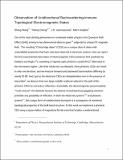| dc.contributor.author | Wang, Zheng | |
| dc.contributor.author | Soljacic, Marin | |
| dc.contributor.author | Chong, Y. | |
| dc.contributor.author | Joannopoulos, John | |
| dc.date.accessioned | 2014-07-22T15:30:38Z | |
| dc.date.available | 2014-07-22T15:30:38Z | |
| dc.date.issued | 2009-10 | |
| dc.date.submitted | 2009-06 | |
| dc.identifier.issn | 0028-0836 | |
| dc.identifier.issn | 1476-4687 | |
| dc.identifier.uri | http://hdl.handle.net/1721.1/88469 | |
| dc.description.abstract | One of the most striking phenomena in condensed-matter physics is the quantum Hall effect, which arises in two-dimensional electron systems subject to a large magnetic field applied perpendicular to the plane in which the electrons reside. In such circumstances, current is carried by electrons along the edges of the system, in so-called chiral edge states (CESs). These are states that, as a consequence of nontrivial topological properties of the bulk electronic band structure, have a unique directionality and are robust against scattering from disorder. Recently, it was theoretically predicted that electromagnetic analogues of such electronic edge states could be observed in photonic crystals, which are materials having refractive-index variations with a periodicity comparable to the wavelength of the light passing through them. Here we report the experimental realization and observation of such electromagnetic CESs in a magneto-optical photonic crystal fabricated in the microwave regime. We demonstrate that, like their electronic counterparts, electromagnetic CESs can travel in only one direction and are very robust against scattering from disorder; we find that even large metallic scatterers placed in the path of the propagating edge modes do not induce reflections. These modes may enable the production of new classes of electromagnetic device and experiments that would be impossible using conventional reciprocal photonic states alone. Furthermore, our experimental demonstration and study of photonic CESs provides strong support for the generalization and application of topological band theories to classical and bosonic systems, and may lead to the realization and observation of topological phenomena in a generally much more controlled and customizable fashion than is typically possible with electronic systems. | en_US |
| dc.language.iso | en_US | |
| dc.publisher | Nature Publishing Group | en_US |
| dc.relation.isversionof | http://dx.doi.org/10.1038/nature08293 | en_US |
| dc.rights | Creative Commons Attribution-Noncommercial-Share Alike | en_US |
| dc.rights.uri | http://creativecommons.org/licenses/by-nc-sa/4.0/ | en_US |
| dc.source | MIT web domain | en_US |
| dc.title | Observation of unidirectional backscattering-immune topological electromagnetic states | en_US |
| dc.type | Article | en_US |
| dc.identifier.citation | Wang, Zheng, Yidong Chong, J. D. Joannopoulos, and Marin Soljacic. “Observation of Unidirectional Backscattering-Immune Topological Electromagnetic States.” Nature 461, no. 7265 (October 8, 2009): 772–775. | en_US |
| dc.contributor.department | Massachusetts Institute of Technology. Institute for Soldier Nanotechnologies | en_US |
| dc.contributor.department | Massachusetts Institute of Technology. Department of Physics | en_US |
| dc.contributor.mitauthor | Wang, Zheng | en_US |
| dc.contributor.mitauthor | Chong, Yidong | en_US |
| dc.contributor.mitauthor | Joannopoulos, John D. | en_US |
| dc.contributor.mitauthor | Soljacic, Marin | en_US |
| dc.relation.journal | Nature | en_US |
| dc.eprint.version | Author's final manuscript | en_US |
| dc.type.uri | http://purl.org/eprint/type/JournalArticle | en_US |
| eprint.status | http://purl.org/eprint/status/PeerReviewed | en_US |
| dspace.orderedauthors | Wang, Zheng; Chong, Yidong; Joannopoulos, J. D.; Soljacic, Marin | en_US |
| dc.identifier.orcid | https://orcid.org/0000-0002-7184-5831 | |
| dc.identifier.orcid | https://orcid.org/0000-0002-7244-3682 | |
| mit.license | OPEN_ACCESS_POLICY | en_US |
| mit.metadata.status | Complete | |
